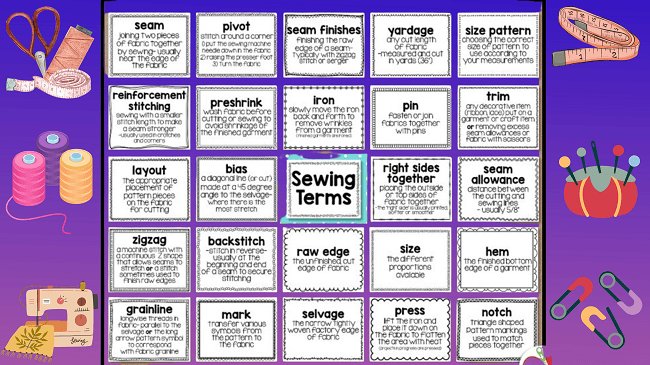When you start out learning to sew, there are many sewing terms used to both provide instruction as well as describe various processes. After you have been sewing for a while these become self-explanatory however if you haven’t reached that stage just yet, the following glossary provides an explanation of some of the most common terms for you.

Baste
This is a long and loose stitch that can be undertaken by hand or on a sewing machine. Its purpose is to hold the fabric in place until you stitch it or gather it. Both ends are not knotted or anchored in any way because you will need to remove it when you complete your project. If you use your machine, remember to set the stitch to the longest setting.
Bias
The bias refers to fabric when it is placed at a 45% angle from the straight grain of the fabric. You cut fabric on the bias when making skirts for example so it will hang a certain way.
Fusing
Also known as Heat ‘n’ Bond, it is used to stick one piece of fabric to another one. You iron it onto one piece of fabric, peel off the backing paper and then iron it onto the other piece of fabric.
Gather
This process is used if you want to create ruffles. You need to start out by using a basting stitch on the relevant piece of fabric. Then holding one end firmly, pull the other end of the thread so that the fabric ‘gathers’.
If you have use a machine basting stitch, you just hold the threads at both ends, slowly pulling the top thread while at the same time, holding the bottom one firmly. As you pull, a ‘gather’ will be created. When you have the desired amount of gathering, you then stitch it permanently into place.
Grain
This relates to the way the threads in the fabric run up and down and sideways to each other.
Hem
You create a hem to finish off the bottom of a piece of sewing, such as on an item of clothing or curtains for example. You just need to fold the bottom ½ inch or sometimes ¼ inch under and press it. Then you fold it over again by 1/2 to 1 inch to eliminate all raw edges, press into place and then stitch by hand or using your sewing machine.
Interfacing
Interfacing is a special type of fabric that you use to stabilize your main fabric by way of strengthening it. You need to sew it onto the inside of the fabric. Some patterns will tell you that interfacing is needed, as well as the specific weight to use. Occasionally a pattern will ask for fusible interfacing to be used and this type irons on and will save you from needing to stitch it into place.
Lining
This is a layer of fabric that goes underneath your project, such as a skirt. It is used to prevent seeing through the outer fabric if it is very thin and transparent. Fabric lining is generally a color that naturally blends in with the outer fabric.
Notions
These are the accessories required for various projects, like a zipper, buttons, thread, and maybe bias tape for example. Sometimes it can refer to a seam ripper and pins.
Raw Edge
This refers to the raw edge of your fabric when you cut it.
Right Side
The right side of the fabric refers to the side that has a pattern or a design on it.
Seam Allowance
This is the fabric that lies between your stitching and the edge of your fabric. ½ and ¼” seams are the norm.
Seam Ripper
You use this sharp pointed tool to rip out a seam when you make a mistake. The sharp point should go underneath the stitch so you can break the thread.
Selvage
The selvage refers to the finished edges of your fabric that you can see when you first buy it.
Top Stitch
This is a finishing stitch on top of a seam you have already sewn. It strengthens a seam and can also be used as a decorative finish.
Turn
Sometimes a pattern will tell you to sew the right sides of a project together and then turn it. You will need to pull the fabric through an opening that you have left along the seam-line so the right sides of the fabric face out when you finish turning.
Wrong Side
This refers to the underside of the fabric.